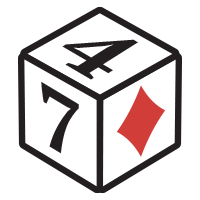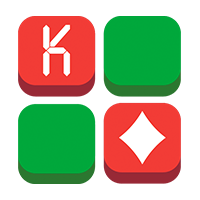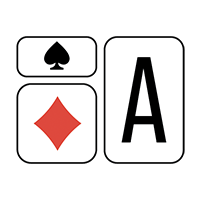Nandez: Today, we're going to jump into a five-card coaching session where Craig, one of our two five-card PLO Mastermind coaches, is coaching me on my latest hands in five-card PLO.
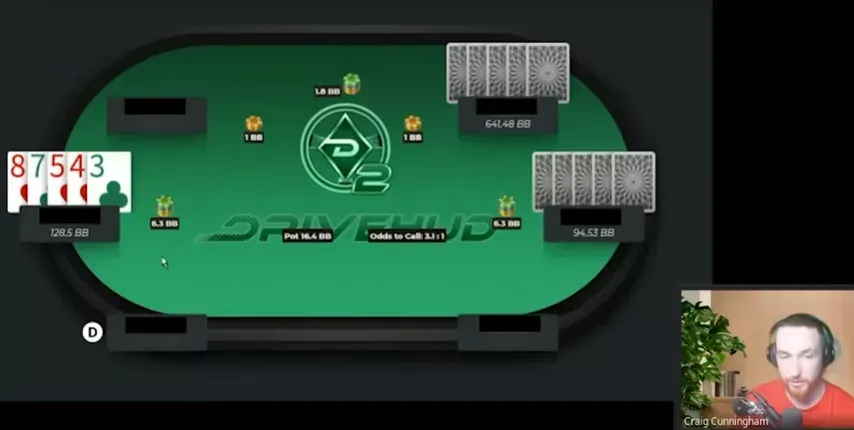
Craig: So, this I'm assuming is going to be like a VPIP table or some sort of dynamic. I guess you would know that this is not going to be a GTO defend in the small blind, or maybe you're overvaluing the connectedness and double suitedness of this hand. What are your thoughts when you see this?
Nandez: My first instinct would be that there is some sort of VPIP problem that I have right now. However, what I took away from our last session was that it is much better to basically throw away, quote unquote, one big blind by just limping some hands that look like complete trash, in case you do want to stay in the game and you want to keep your VPIP where it needs to be, versus calling a raise that includes all antes, where you're going to play a much bigger part down the road, like in this case.
So, I think again this is a hand that is not new; still, the mistake I made in our first session was yeah, so I would say it's an adjustment. But what I do wonder is when do double-suited low rundowns ever become either playable or even good? There are some high-quality ones in four-card (no gaps, double-suited, very high VPIP hand); is that sort of similar in five-card, or are actually most of them pretty much trashy?
Craig: There's definitely combos that we can call here, but we really need to be very suited and very connected, meaning if we want to call it an eight-high rundown, it probably literally needs to be 8-7-6-5-4 with the perfect suits. So, if we have a look at unpaired double-suited five-card rundowns, we can have a look at what the 16% looks like.
Nandez: Zero, one, or two gaps would still count as a five-card rundown, but so are four-card rundowns, I guess, with a dangler that just doesn't really count.
Craig: If we have a ten instead, it doesn't count as a rundown. If we have a nine, then it still counts as a rundown. So, nine would be two gaps, which would be the yeah, and our hand was a fold right. But what about the perfect eight-high rundown? So, let's say 87654; we actually call 100% of these, and these are all the double-suited versions. Let's say we have a three instead of a four; I would imagine these all turn into folds because the three is just really bad.
So, the connectedness of the bottom cards is very, very important. We're losing almost a big blind by making a call like this, probably more in practice because in practice, the big blind's probably going to come along too often, and our flush draws are actually going to be even more dead. But then if we think if we just limp almost any hand on the button, we're probably losing less than a big blind because often it's going to go limp and check, and then we get to see a flop in position. So, maybe we only lose like 0.5 big blinds by folding this on the button for example, rather than calling it in this spot.
Craig: Okay, so we end up going for the limp-call here, and what I would say about this is that we shouldn't be afraid to just limp and fold a lot of these combos.
We need to limp some of them because we want to reach the VPIP, but a lot of people make the mistake of thinking just because they limped, they now need to call this kind of massive raise, and if it isn't a hand that you would call in the big blind versus a big raise (which this hand is not most of the time), then it's probably a hand that you should not call after you limp and get isolated.

The limp is perfectly fine, but the call is probably losing, and that's just because reverse implied odds by hitting a set are going to be so much higher.
If we think about what happens when we call this hand, like what boards are we really excited to put a full stack in on the flop, so you can see even the double-suited versions of this hand are often just going to fold versus this raise. Yeah, so you can see even like A-K-9-9-3 with the Ace King of Diamonds; we just want to fold to this raise just because it performs so badly post-flop.
Craig: This is probably also in the context of a VPIP game; I would imagine—is this a hand you would ordinarily limp with a big ante in play, or what do you think about this?
Nandez: So, we have a limp ahead of me and one and a half antes or one and a half big blinds of ante. Intuitively, I would think I would actually limp even without a squid game. Would you say that would be a mistake?
Craig: Yes, I think so, kind of for the same reason as the hand that we went over to start with, the 8-7-6-3-4. Because if we limp here, we're basically saying we're happy to go multi-way with this hand, and this is a hand that just does not perform well multi-way. I should say the caveat to this is if we are against, let's say, two very tight ranges—so let's say EP opens and MP calls—we probably actually want to defend this in the big blind because very rarely are our straight draws going to be dominated. If we were up against two tight ranges, I would imagine that this hand actually defends at some frequency, even 100% of combos like even quad-suited.
However, this is not GTO, and we're probably up against, like, maybe a 50% range here.
Actually, I'll put my HUD on and see what VPIPs these guys are playing.

So yeah, let's say this guy limps 40%, the big blind's playing 70%, and this guy to your left is playing 40%. Suddenly, our draws are going to be dominated a lot, and so we actually go from having very little reverse implied odds in GTO here, calling in the big blind, to a huge amount of reverse implied odds given that we are going to play against multiple very wide ranges. And hands just like K-Q-10-4-5 single-suited just have us crushed basically.
Nandez: So, I have a limper in front of me, and there's antes worth one and a half blinds in the pot. I guess that's the default limp for me. Mistake?
Craig: Yeah, that's a good question. Intuitively, I would say no, but the solver does solver things, and it would make sense if we know we're up against very tight ranges here. So, let's say we have 7-6-5-4-3; wow, you're right, you're right, I would never call this in the big blind. So, this is pretty cool to find. Like, if we are up against two extremely tight ranges, even if we see a raise in a massive three-bet, we can actually defend the double-suited versions here just because we're not going to be sharing outs—at least our straight outs or two-pair outs—with these two ranges.
Nandez: It's one of those where people have to be really careful, like if you're playing some crazy games or people are like opening wider, three-betting wider; it probably is very sensitive to the ranges in play. And I also wonder, like, let's say we had a Jack-high rundown? I guess that is still premium against what we're going to see. If we filter this by EV, I guess we could see like what the printers are as a cold call in a spot like that?
Craig: So, like King-Queen-Jack-10-9, of course, that's just going to be good against any range basically because it's so pure. Also the 8-7-6-5-4 double-suited. Seems like we want to be perfectly connected for these hands, the highest EV ones at least. I would imagine as soon as we start seeing some gaps, we probably don't want to be this liberal with calls.
Nandez: K-J-10-9-8, I saw in there, and K-J-10-7. The Jack-10 are the two most connected cards in the game, I mean in Hold'em and PLO. I guess that's the exception. If we have Jack-10-9, Jack-10-8, it's usually a catalyst for VPIP in some ways. I guess in this case, it's kind of similar.
Craig: Yeah, like if we always want the perfectly connected hands, but the second-best kind of hands to be aggressive with or to get in the mix with are almost always going to be unpaired Jack-10-8 combos. You'll see this in spots like this; you'll see this as our four-bet bluffs as well. Like if we raise in the cutoff and get three-bet by the button, all of the hands that we want to four-bet that are not aces are basically going to contain either a 10 and an 8 or a Jack and a 10 or a Jack-10 and 8 sometimes Jack-10-7. But they're going to be based around these three, and I think just combinatorically, it gives you like the perfect amount of board coverage.
Nandez: I see even if we have a King-high, Queen-high, Jack-high flush draw, because we're so well connected, we will usually have a pair, wrap, two pair with the flush draw, something along those lines that can just get the money in regardless of the SPR. Playability is not as important; it's just like how much equity you just flop exactly.
Craig: For example, if we have like King-King double-suited here, I doubt we're doing very much calling; yeah, we're folding 75% plus at the time. Even like Ace-King, King-Queen, King-King-10-9-6, these very like premium double-suited King-King combos just because with the unpaired combos, we're just going to flop like middle pair with an open-ender and a flush draw so much more often than we will with like King-King-10-6-4, where if we call, maybe we flop overpair with a flush draw, but that's nowhere near as strong to stack off with as like middle pair with a gutshot and a flush draw that we will flop a lot more of with unpaired hands here.
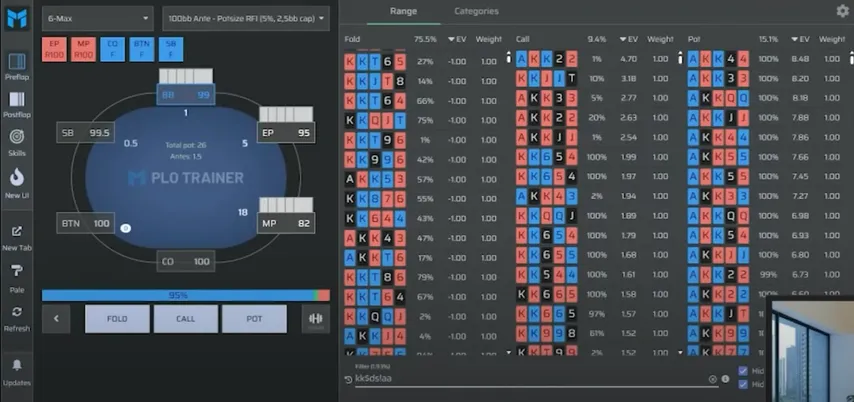
Nandez: Yeah, just probably a common mistake—overvaluing double-suited Kings in five-card PLO.
Craig: I'd say the number one pre-flop mistake that people make. For example, if we look at like a 100 big blind stack, let's say we get raised in the small blind by the button and we three-bet a lot of double-suited King-King combos. When we get four-bet, I know some players will just call like 100% of their double-suited King-King combos here because they think, "How could we ever fold such a beautiful hand?" But then if we look at what we do versus a four-bet with double-suited Kings with no Aces, we only defend like 20% of them.
Nandez: 80% fold! That's pretty brutal.
Craig: And especially when we have an Ace, if we have an Ace-King-King combo, I think we fold like 100% of the time. We call like basically if we have the perfect suits and a pair along with it, but even then, these are basically like break-even defends. And if the button is only four-betting Aces, which a lot of people will be in the population, then a lot of these defends are even going to become quite negative EV to defend. So, my general rule would be like if I three-bet Ace-King-King combos and get four-bet, I just fold unless I know for a fact my opponent is four-betting too wide, which will be the case sometimes, but mostly it won't be.
Do you want to keep going with the pre-flop stuff?
Nandez: I think it would be good to move a little bit to post-flop.
Sometimes we go quite deep on certain subjects, but the idea is to not only explore one hand but more so bigger concept ideas that build this web of concepts that are applicable across the field or in different spots as well. So, if you studied the game, I strongly recommend people to go down these tangents yourself because what you want to avoid is just having this sort of confirmation bias study approach where you look at a hand, was it good, was it bad, I played it great, let's move on. But if you go deeper, you learn about the threshold points, but you also ask yourself these conceptual questions.
Craig: 100%. Yeah, I have students who will say like, "Oh, I've got like 30 hands tagged for our coaching session." I'm like, "You only need two; two will give us enough material to work with for an hour."
Nandez: That's a long coaching session with 30 hands.
- Increased first deposit bonus
- Increased rakeback and reloads
- Help with deposits and cashouts
- Access to private freerolls
- Round-the-clock support
Craig: So, our opponent in under the gun, 2.5x, is a very spewy player, goes for a small three-bet. We go for the four-bet, of course, and get called. SPR is 6; actually, I don't remember tagging this, but this one feels fine.
The thing I would be thinking when I'm deciding if I want to C-bet here or not is like what turn cards can I actually jam on? Because if we bet, let's say, half pot here, and he calls on the turn, there's going to be 100 in the middle, and yeah, the SPR is going to be like 2.7, which is a little bit awkward. So, we definitely want to only bet hands that can actually pot on a lot of turns with the objective to stack off.
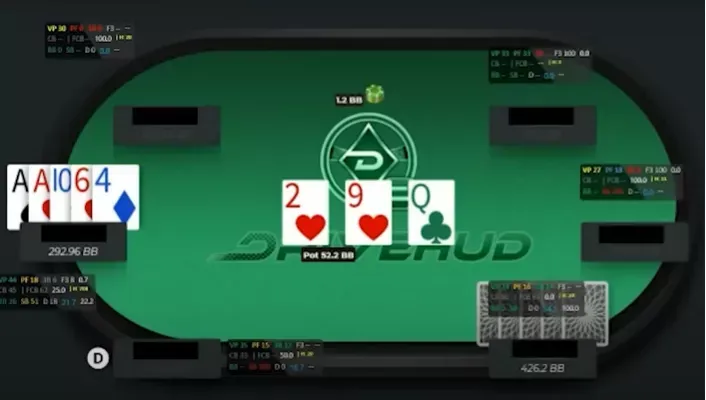
So, if we had like, um, if we had like Ace-Ace, maybe by five deuce here, we with the nut flush draw, we probably don't want to bet because actually on like a six, a seven, an eight, a nine, a ten, a jack, a queen, a king, we can't really do anything because we're not going to have the equity to stack off, and these are cards that are going to hit our opponent's range. Having hearts here makes this a slam dunk bet because we now have like an extra 25% of cards on the turn that we can just put and be happy about it, because that's often going to make the difference between whether we want to bet out of position or not.
I think it's true in four-card as well, but especially in five-card, when you're thinking about taking an aggressive action out of position, having a backdoor flush draw is often going to be the deciding factor. So, not only in three-bet pots like this, but if we are considering like betting out of position in a single-raised pot, cutoff versus button, or we are thinking about donking in a single-raised pot from the big blind because we're going to be out of position in each of these nodes, we really want that backdoor flush draw to make our life navigating on the turn a lot easier.
Nandez: SPR 4 versus SPR 6 is very different. SPR 4 basically means you pot the flop and you pot the turn; you're all-in. So, SPR 4 equals two pot-sized bets. In four-card PLO, when you look at the sims we're running, when the SPR is 4 on the flop, you will see a lot of potting out of position because you want to reduce the game tree to two streets by betting pot on the flop; you can jam the turn. This is not possible here, and so what the solver usually does is it doesn't prefer to bet as frequently on the flop, of course, you're out of position, you're now deep-stacked, quote unquote, and it also doesn't go for the pot-sized sizings as much.
Like, I would probably simplify this to something like half pot to two-thirds, and the implication is that we have a hand like we're betting less often and we're more focused on playability. Playability is the big question mark here: does our hand have playability or not over three streets? Because, as you were saying, we're not going to end this hand on the turn that often unless we're behind—say the turn is a jack and we want to pot for whatever reason; we might end it there, but it's not going to go well for us; we're going to be a big equity dog.
The question to you is like, do you think check-raising all-in is good once we check, or should we check-call? Are we strong enough to check with SPR 6 for stacks?
Craig: That's what I was thinking; it feels very, very close because SPR 4, we can definitely either pot the flop or we can check-jam the flop and not even worry about it. SPR 6 gets a little bit weirder because when he does stack off at SPR 6, we're probably not going to be doing that well equity-wise. Like, 6, we need B, like 45-46% equity on the flop against his range; we're probably not reaching that 46% equity; it's going to be close but probably not.
Now, if we had, um, let's say a 9-6-4, so we had this pair blocker, suddenly our equity for check-raising goes up a lot because not only can we hit our flush, but we can also hit two pairs or trips sometimes to beat his like King-Queen-Jack or whatever. Or sometimes like his nut flush draw. Intuitively, I think this is just okay to go for a check-raise. Another option that I don't think really exists in four-card but is very prevalent in five-card in three-bet pots is going for a check-check-call and then donking on the turn full pot on safe turns.
So, let's say we go for a check-call here and then the three of diamonds comes on the turn; we can just pot it because now the equity has actually shifted in our favor.
If the turn card comes like even a six—like the six of diamonds—we can probably just pot it in his face because the equity again has shifted in our favor with only one card to come. Now, with two cards to come, I'm not sure we're really pushing enough equity here, but I'd be very curious to see a sim for this hand.
Nandez: It's also if we play check-call on the flop and the turn rolls off as a heart, I think we can definitely still get paid because the assumption is that if we have the nut flush draw, a lot of those hands want to bet, want to check-raise; they want to put in all the chips because if we had Ace-Queen of Hearts, if we had Aces-Jack-10, Aces with hearts and clubs, like all those hands, they want to jam. So, once we play check-call, I can see our opponent thinking we might have the nut flush blocker with some sort of side equity; we're trying to draw to. Let's say we had like A-A-J-10 with the Ace of Hearts but no flush draw; we would have Aces with backdoor clubs and a gutter and the Ace of Hearts, and those hands will then be turned into bluffs.
So, even playing check-call, I think we can get paid once we hit while avoiding stacking off on the flop or building a huge pot for bad turns, which there are plenty of. So, I think more and more, the more I think about it, I think check-call is a smooth line and maybe the best line.
The thing you touched on, which was how much equity do we need to stack off—let's say it's 46%—now that tells us if a stack is profitable, but it doesn't tell us which line is the most profitable. And often times, when you find yourself in a spot where you just have about enough equity to get the money in, you should think about other lines where the EV is going to be better.
Craig: Just out of curiosity, I got the SIM for this exact board if the SPR is 3.5. Obviously, we're going to want to stack off a little bit more liberally, so we are correct that we can just pot this hand if the SPR is lower. But we will actually go for some half pot, and this is quite a good example as well of how much of a difference having a backdoor flush draw is going to make to our playability. Without the backdoor flush draw, we just want to pot; we want to end the hand as soon as possible or we want to make the SPR on the turn as low as possible so that we can just jam. But if we have the backdoor flush draw, and especially the backdoor nut flush draw, we would actually prefer to half pot because we're really not worried about as many turns
Nandez: That's a great find, and I think the way people often ask how do I apply the sims you have in PLO Trainer to other situations—let's say you're deeper stacked—I think that's a good way to think about it.
At 100 big blinds, your playable hands with the backdoor flush draw are betting half. At 200 big blinds, once you're deeper, those are the only hands you want to start betting because they have the playability. And the hands on the right-hand side are probably hands you lean much more towards checking because they don't have playability. And you don't pot at an SPR of six. I think this is a good point to wrap it up. Like, we dove a little bit deeper today into five-card PLO. I appreciate Craig for joining us today; he's obviously one of the two PLO 5 Mastermind coaches. Next time, we're going to dive deeper into post-flop.



